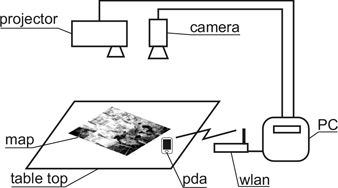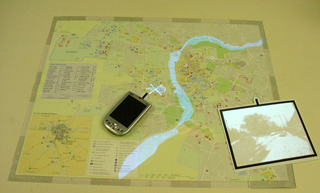Dr Tom Drummond, Dr Gerhard Reitmayr, and Ethan Eade are combining the benefits of printed maps with the benefits of computer based dynamic maps, creating a dynamic high resolution map by augmenting printed maps with digital graphical information.
Printed maps can be designed and printed to show fine detail and yet remain easy to take in at a glance. They are also simple to use in group discussions. However, a new map needs to be printed whenever information changes. Computer-based maps on a screen can change dynamically to represent a changing situation, but are not as easy to use. Dr Tom Drummond, Dr Gerhard Reitmayr, and Ethan Eade are combining the benefits of printed maps with the benefits of computer based dynamic maps, creating a dynamic high resolution map by augmenting printed maps with digital graphical information.

Tom's demonstration of the dynamic paper map comprises of a camera and a projector looking down at a paper map from above. The system performs interactive tracking of the map on a table top environment using the live video stream captured by the camera. Once the locations of the maps are known, the projector displays extra information directly on the maps.
The system also tracks user interface devices which can be placed on the map and which enable access to information that is linked to locations on the map. A simple physical prop, for example a piece of white card, becomes a selection tool and projection surface at the same time. Images referenced by the location pointed at are displayed in the white card.
The system also lets the user interact with real and virtual assets on the map using devices such as a personal digital assistant (PDA).

Tom and his team have implemented a flood control application for the city of Cambridge to demonstrate possible features of augmented maps. The River Cam running close to the city centre of Cambridge can flood the surrounding areas, which are lower than the water level of the river in a number of cases. In the event of real flood, the water line needs to be monitored, threatened areas identified and response units managed. Information provided by local personnel helps to assess the situation. An augmented map provides the ideal frame for presenting and controlling all the relevant information in one place and for a team of people to manage the situation.
The images above show a Cambridge flood scenario. The left column shows the normal state, while the right column shows the extension during a flood. The image browser shows images associated with the state of the river and the location.
A map of the interesting area is augmented with an overlaid area representing the flooded land at a certain water level. The image above shows details of a map of Cambridge overlaid with the current expansion of the River Cam. The overlay changes dynamically with the water level which is controlled by an operator on the PDA device. Certain endangered compounds are highlighted in red with an animated texture when the water level reaches a critical level. Other information sources include images provided by ground personnel at various locations. Green icons represent the locations and directions of these images. Using the image browsing prop an operator can see the image and assess the local situation immediately. An emergency unit represented as a helicopter is visible on the map as well. By placing the PDA next to it, a corresponding graphical user interface appears on it to present more status information and give orders to the unit. Here its direction and speed can be controlled. Another function of the PDA interface accesses web pages of relevant places on the map. Purple circles represent corresponding locations and placing the PDA next to them presents the associated website.
Augmenting paper-based artefacts offers the advantages of high-resolution printing, familiarity to users, and tangible qualities with the flexibility of digital information. For future work, Tom and his team will further automate the calibration of the setup to make it readily deployable and mobile.

